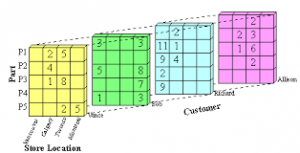Articles
Data Cubes
Christopher Breece
Data cubes are multidimensional extensions of 2-D tables that allow one to go beyond just rows and columns (computerworld.com). They can be in many dimensions, e.g., Microsoft Server Analysis Services allows data cubes to contain all the rows listed within the data. A dimension represents an attribute in the database while each cell represents the measure of interest. For example, the minimum, maximum, sum, or average of each attribute (uregina.ca).
In MIS2502, we learned about relational databases, ways to analyze data, and how to find patterns within the data. Data cubes can allow us to expand upon this knowledge. For example, they allow a relational database to display beyond just rows and columns. While it may provide the user with sales by country, data cubes can provide sales by country by product by manufacture; all at once. As well, they allow for new or unexpected pattern creation leading to greater association rule mining. With the ability to compute data beyond 2-D tables, patterns may be discovered that aren’t yet known or defined. They can then be tested with association rule mining to measure their impact.
As mentioned previously, cubes allow the user to add or subtract as many dimensions as they wish, leading to faster and perhaps unexpected insight. But data cubes also allow for hierarchical relationships, meaning the user can ‘roll up’ or ‘drill down’ for each attribute (sciencedirect.com). For example, if they roll up, they can easily go from city to state or perhaps country to continent. As well, if they drill down, they may go from state to county. Users can quickly measure dimensions on multiple hierarchical levels without having to create a new model. In all, data cubes can be useful with nearly all datasets and should not be ignored.

3 Dimensional Cube Example
Bibliography
Duncan, Owen, et al. “Dimensions in Multidimensional Models.” Microsoft Docs, 1 May 2018, docs.microsoft.com/en-us/sql/analysis-services/multidimensional-models/dimensions-in- multidimensional- models?view=sql-server-2017.
Hamilton, Howard. “Data Cubes.” Introduction to Data Cubes, 2009, www2.cs.uregina.ca/~dbd/cs831/notes/dcubes/dcubes.html.
Han, Jiawei, et al. “Data Cube Technology.” ScienceDirect, Morgan Kaufmann, 24 June 2011, www.sciencedirect.com/science/article/pii/B9780123814791000058.
Jain, Piyush. “Data Cubes Are Critical to Financial Analytics – Here’s Why.” Medium, Fintech Weekly Magazine, 15 June 2018, medium.com/fintech-weekly-magazine/data-cubes-are-critical-to-financial- analytics-heres-why- 5ae328dd83cd.
Kay, Russell. “Data Cubes.” Computerworld, Computerworld, 29 Mar. 2004, www.computerworld.com/article/2564238/data-cubes.html.
“What Is a Data Cube? – Definition from Techopedia.” Techopedia.com, www.techopedia.com/definition/28530/data-cube.

